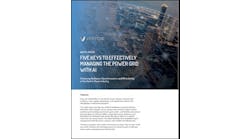A study from the University of Delaware of about 900 New York state consumers found they’re willing to pay an average of $14 per month for access to resilient microgrids that provide emergency services and potable water to communities during outages.
The study, “Willingness to Pay for Microgrids to Enhance Community Resilience,” provides some meat to help answer questions about how to place a value on resilience. Creating an electric resilience metric is an important goal for the microgrid industry. It’s also part of an effort by the California Public Utilities Commission to speed the deployment of microgrids.
Demographics played an important role in the amount consumers are willing to pay. The survey found that families with children plus people under age 50 were more willing to pay for community microgrid services.
The study aims to inform utilities, regulators and policymakers about consumers’ willingness to pay for community microgrid services — information that may help them determine how to fund community microgrids, said Martin Heintzelman, chair of the University of Delaware’s Department of Applied Economics and Statistics and one of the report’s authors.
“This estimate can then be balanced against the costs of any particular system to provide guidance as to whether the benefits of the system (partially represented by household willingness-to-pay) justify the costs,” he said.
Water yes, banking no
The report applied the willingness-to-pay estimates on a community level, concluding that for a community with 10,000 households, community members together would be willing to pay $140,504 per month, or $1,686,050 per year, for microgrid services.
“These annual payments could justify upfront expenditures of up to $25.9 million (not accounting for any operations and maintenance costs),” according to the report’s conclusion. This translates into a consumer willingness-to-pay for a 12-MW microgrid in a community of 10,000, the report said.
Of five services, respondents said they’d be most willing to pay for a microgrid that could provide power for emergency services and potable water. The five services the report examined were hospital services, emergency services — fire, emergency medical workers and police — potable water, shelter and retail services, said Heintzelman.
“The overall magnitude of willingness-to-pay was a bit higher than expected as $14 a month for the provision of public good services (as opposed to individual household power service) would represent a substantial increase for most people’s utility bills,” he said in an email.
Respondents said they were less likely to pay for a microgrid to maintain retail and banking services.
Households with children more willing to pay
Interestingly, people who had experienced longer term power outages were less interested in paying for community microgrids. The authors speculated that these people might have a stronger sense that they can or will “survive” outages and know that they are prepared with strategies to do so, said Heintzelman. “People who have not experienced these outages may be less confident in this, more fearful, and perhaps less prepared, at least mentally,” he added.
The survey found that men were less likely to choose microgrid services, compared to women. And more conservative respondents had a lower probability of choosing the microgrid services.
High energy users were willing to pay significantly more for all five categories of services. That may be because microgrids can help get the grid back online more quickly, the report said.
Households with children were likely more interested in community microgrids because they’re more risk averse and more concerned about access to emergency and hospital services, according to the report.
The study results apply not only to microgrids, but to any policy or system that helps maintain critical services during emergencies, the report said.
The results likely apply more to small and midsized communities in the Northeast and mid-Atlantic. “We are reluctant to apply the results to places with substantially different conditions, be those differences in demographics, in the power system, or in the frequency and severity of storms that help create outage events,” said Heintzelman.
Because utility investments are recovered through rates, the report provides important information about what consumers are willing to pay for a community microgrid.
Embed in utility rates?
Questions abound about whether all utilility customers should pay for microgrids.
Edison Electric Institute has argued that microgrids should be rate based for two reasons. First, test microgrid projects such as the Bronzeville microgrid in Chicago provide important information about the benefits of microgrids. Second, microgrids can provide benefits outside the microgrid. Having police stations or communications centers up and running during an outage can help restore the rest of the grid.
But some argue that microgrids should not be rate based because they don’t directly serve all utility customers.
“Given that the rate-based structure for recovering investments guides electric utility investment decisions, trying to determine what consumers would be willing to pay for the existence of a resilient microgrid in their community is critical,” said the report.
If a utility is not the owner of the distributed energy resources powering the microgrid, the utility might still be involved with recovering costs. That’s especially true if the microgrid construction requires installing underground distribution cable to provide power between the entities connected to the microgrid, the report said.
“These results provide critical evidence for rate makers and utilities in evaluating societal benefit when making investment decisions for microgrids and related infrastructure,” the report said.
Interested in microgrids? Subscribe to the free Microgrid Knowledge Newsletter.








